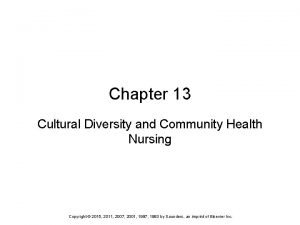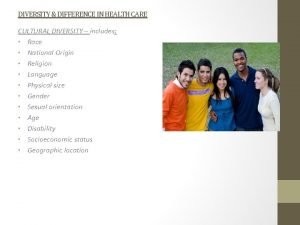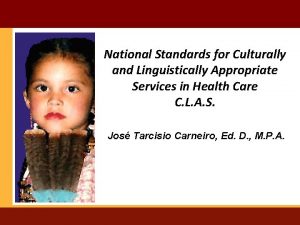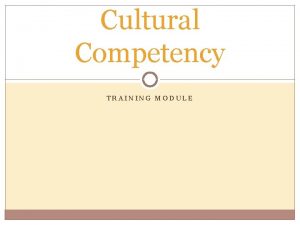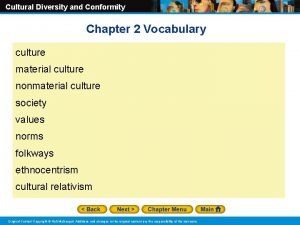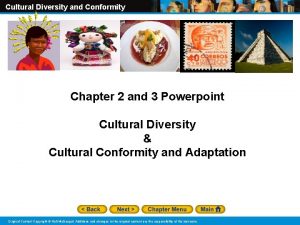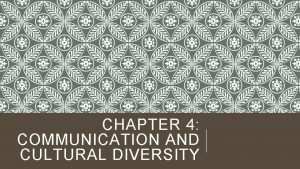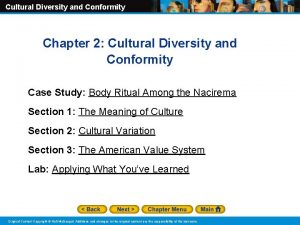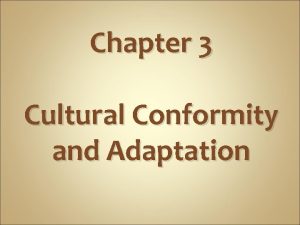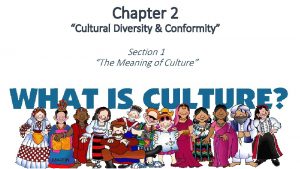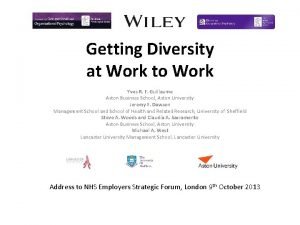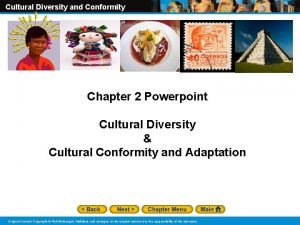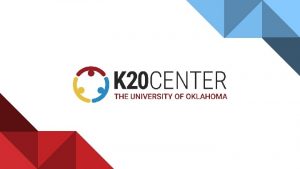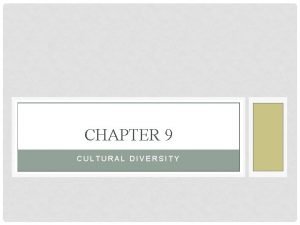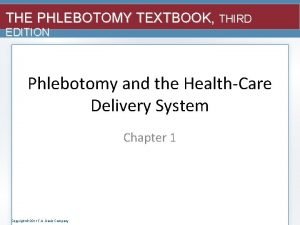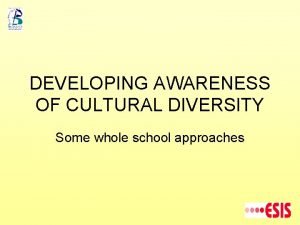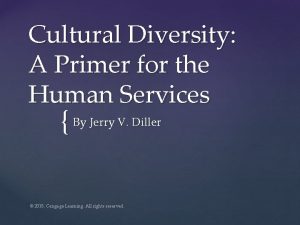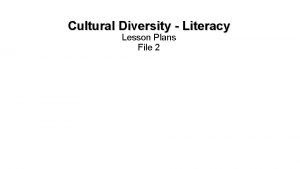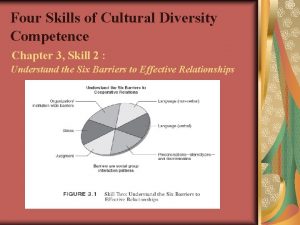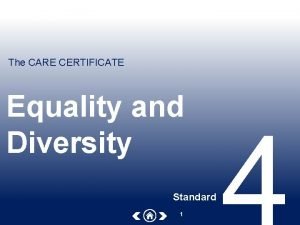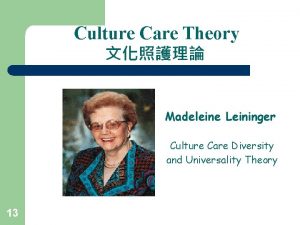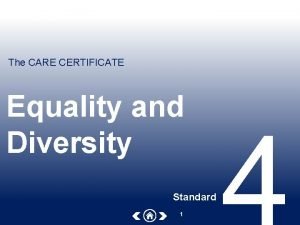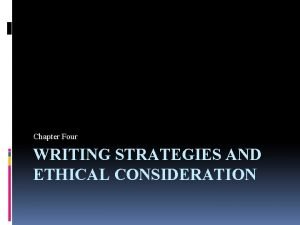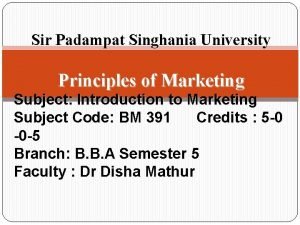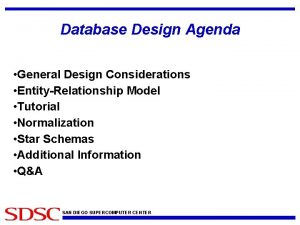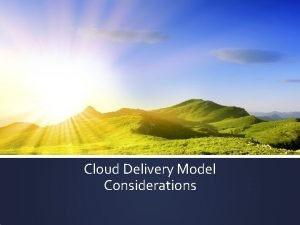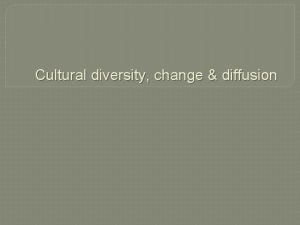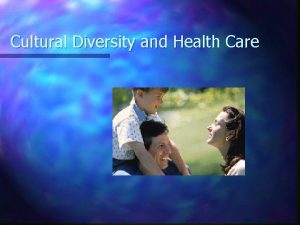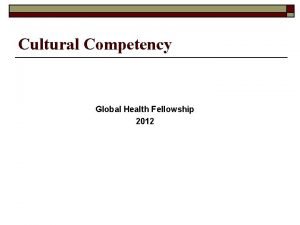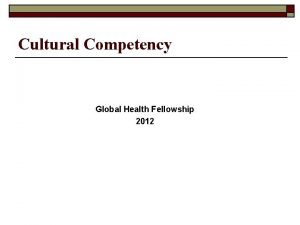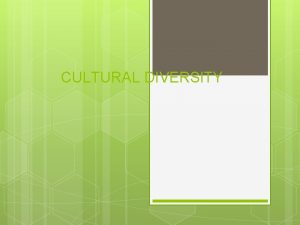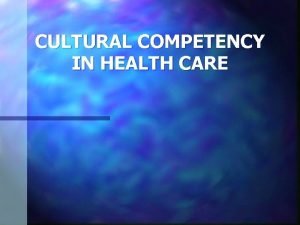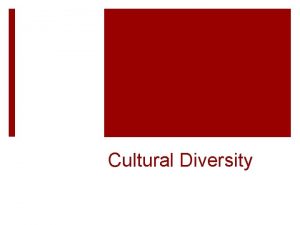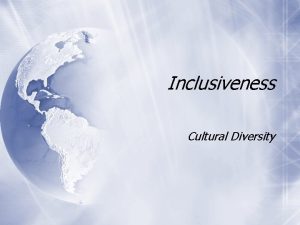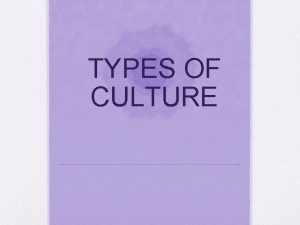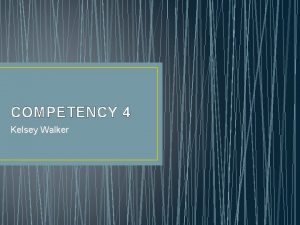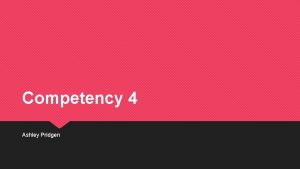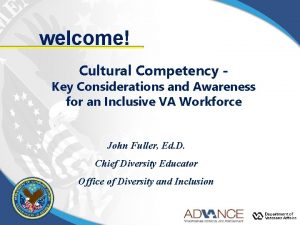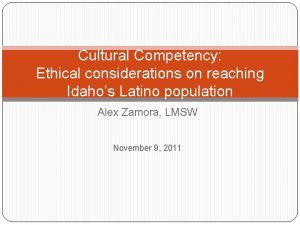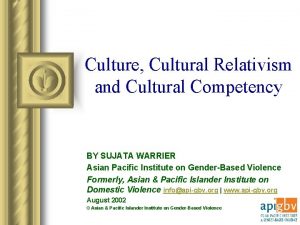Cultural Diversity and Competency Considerations for Health Care
















































- Slides: 48

Cultural Diversity and Competency Considerations for Health Care Presented by John Fuller, Ed. D. VACO ODI Chief Diversity Consultant Lisa Red, VHA Director of Diversity

Learning Objectives At the end of the training, the learner will obtain information on the following: 1. Awareness of VHA Patient Centered Philosophy 2. Considerations in relation to cultural diversity and cultural competency affecting health care 3. Insights into the aspects of cultural competency lifetime learning process

VHA Defining Excellence Patient centered; Characterized by team care; Continuously improving itself; and Data driven, evidence based

Team Care Diversity Inclusion Business case ◦ Innovation ◦ Decision Quality ◦ Problem Solving

Patient Centered* • • • Solicit and respect the Veteran’s values, preferences and needs Empower Veterans through information and education Incorporate the nutritional, cultural and nurturing aspects of food Ensure emotional and spiritual support Encourage involvement of family and friends *Veterans Health Care: Leading The Way to Excellence Universal Services Task Force Report

Continuously Improving & Evidence Based Innovation requires you to change the rules of engagement ◦ What assumptions am I making, That I am not aware I am making, That gives me what I see? Do not go where the path may lead, go instead where there is no path and leave a trail. Longfellow

Unconscious Bias* Our brains unconsciously make decisions on what feels safe, likeable, valuable, and competent. “We make decisions largely in a way that is designed to confirm beliefs that we already have. ” Unconscious beliefs impact the way we perceive others, perceive ourselves, and as such influence our organizations. *www. cookross. com Dr. Howard Ross

Current Headlines • Unemployment 9. 1% • More couples for first time in history are not married • • Backlog buries Veterans’ claims extending processing times Job front bleak for Veterans 20% of Homeless Majority of US born babies now minorities (Census 2010) Sexual assaults at VA facilities victimize the most vulnerable

Symbols – What do you think? Gladiator Signal from Emperor Life or Death?

Cultural Derailing Behaviors Carry A Powerful Impact Doesn’t Matter What Message You Send Only the Message That Was Received! It is a Co-Responsibility

Pushing Buttons or Can Buttons Push You?

How Many Symbols Can You Identify? Christian Cross Star of David Muslim Crescent Hindu Omkar Shinto Torii Hindu Lotus Flower Sikh Khanda Toaist Taiji Zoroastrian Faravahar Baha’I Nine Pointed Star Buddhist Dharma Wheel Jainism Wicca Unitarian. Universalism Unification Church Atheist

“Wired Culture? ” How Honest are You on Social Websites?

Defining Cultural Competence A defined set of values and principles, and demonstrated behaviors, attitudes and structures that enable employees and leaders to work effectively cross-culturally. Managing Diversity At Duke University: A Toolkit for Managers: Cultural Competency 14

What is “Cultural Competency? ” CULTURAL COMPETENCY acknowledges that, while people develop a more or less automatic depth of understanding of the subject positions and cultures into which we are born and socialized, achieving something like that depth of understanding of other subject positions and other cultures is far more difficult, but not impossible. The process of gaining depth of understanding of subject positions and cultures other than your own is the process of gaining various degrees of CULTURAL COMPETENCY

Cultural Diversity and Health Care The Cultural Competence Continuum ◦ Where Are We Now? ◦ Where Could We Be?

Cultural Competence Continuum Cultural Proficiency Systems and organizations hold culture in high esteem, as a foundation to guide all of their endeavors. Cultural Competence Systems and organizations that demonstrate an acceptance and respect for cultural differences. Cultural Pre-competence Awareness within systems or organizations of their strengths and areas for growth to respond effectively to culturally and linguistically diverse groups. Cultural Blindness Expressed philosophy of viewing and treating all people as the same. Cultural Incapacity Lack of capacity of systems and organizations to respond effectively to the needs, interests and preferences of culturally and linguistically diverse groups. Cultural Destructiveness Attitudes, policies, structures, and practices within a system or organization that are destructive to a cultural group. National Center for Cultural Competence (NCCC). Cultural Competence Continuum. Adapted from Toward A Culturally Competent System of 17 Care, Volume 1, Cross et al.

Primary Dimensions of Diversity

Secondary Dimensions of Diversity

VIDEO GAMES PEOPLE PLAY Video games now quite different from the days of Pong and Mario Brothers Bloody Day Don’t Shoot the Puppy Sniper Assassin 2 Beat Me Up Exit Wound 20

Ascribed Characteristics of 4 Generations Traditionalist Baby Boomer 1922 – 1945 • • Greatest Generation Matures Silent Generation Veterans 1943 – 1965 • Boomers Generation X Millennial 1963 – 1982 • • • Baby Bust Gen X Xers 1978 – 2002 • • Digital Generation Echo Boomers Generation E Generation Y Nexters N-Gens Net Generation Source: Generational Differences in the Workplace by Anick Tolbize, August 16, 2008 21

Generational Differences Traditionalist Outlook Baby Boomer Generation X Generation Y/ Millennial Practical Optimistic Skeptical Hopeful Dedicated Driven Balanced Ambitious Respectful Love/Hate Unimpressed Relaxed, Polite Hierarchy Consensus Competence Collaboration Relationships Self-sacrifice Selfgratification Noncommittal Loyal, inclusive Perspective Civic-minded Team-oriented Self-Reliant Civic-minded Turn-Offs Vulgarity Political Incorrectness Clichés, Hype Cynicism, Condescending Work Ethic View of Authority Decisionmaking Adapted from Talent Strategies Update: International Association for Corporate & Professional Recruitment, 2011 -01. 22

Sound Familiar? Seeking challenge Looking for meaningful work Chance to prove themselves and show they can perform well Enjoys contact with people Desire to be in a position of responsibility Resents being looked at as though they have no experience Tends to be more job mobile Less respectful of authority What Generation does this describe?

Sorry Boomers, the other Generations in the workforce didn’t like you when you started working! Previous slide information contained in the November 1970 Edition of Training and Development Journal Every generation that enters the workforce makes waves!

What complaints or concerns have people managers in your organization raised about the performance of younger workers? Inappropriate dress Poor work ethic Excessively informal language and/or behavior Need for supervision Inappropriate use of or excessive reliance on technology Lack of respect for authority Lack of respect for organizational hierarchy Inability to balance work and life Inability to navigate office politics Inability to work within a defined structure Low productivity General skills deficiencies Inability to work as part of a team 55% 54% 38% 38% 36% 35% 28% 24% 22% 19% 18% 17% Note: n = 242. Excludes responses of "N/A, not aware of any complaints or concerns raised by people managers regarding younger workers. " The response category "Unrealistic expectations of employment, current job and/or advancement" was added based on the write-in responses to "other. " Percentages do not total 100% due to multiple response options.

Traditionalist/Baby Boomer Perspectives Young people have an attitude problem Want everything on their own terms Don’t understand “paying dues” concept Want expensive training right away Work minimum hours and then go home Have short attention span I am doing more parenting than managing They dress too casually for the workplace

Events and Experiences The Greatest Generation Great Depression New Deal World War II Korean War Frank Sinatra Gone with the Wind John Wayne, Bob Hope Honeymooners Sputnik went into Orbit Party Line Phones Boomers: Civil Rights Woodstock Cold War MLK/JFK, RFK Deaths Room size computers Man Walks on the Moon Vietnam War and Protests Captain Kangaroo Elvis, Rolling Stones Beam Me Up Scotty Hippies (Peace, Love) Digital Phones

What complaints or concerns have younger workers in your organization raised about older managers? Resistance to change Low recognition of workers’ efforts Micromanaging Rigid expectations of following authority/chain of command Aversion to technology Low respect for workers’ work/life balance Generally poor management skills Inflexibility Poor training/coaching skills Unfair or excessive criticism “Out of touch” with the reality of the job Excessive workload Excessively formal expectations for dress 47% 45% 44% 38% 31% 29% 28% 26% 24% 17%

Generation X & Y Perspectives I don’t like being stuck in a cubicle with nothing to do Supervisor has hardly any contact with me My skills have not been tested I don’t want to be locked in a dead-end job Nobody asks for my opinion Nobody recognizes my contributions

Events and Experiences Xers: Millenials: Fall of Berlin Wall Watergate Women’s Liberation Desert Storm Energy Crisis AIDS Identified Schoolhouse Rock, Sanford and Son Single Parents Cell Phones/Real Computers Both parents working School shootings Oklahoma City, Columbine Everyone Knows (Facebook) Child focused world Multicultural Techno Savvy, Smart Phones/IPAD Iraq/Afghanistan Everyone Hates Chris Reality Shows, Dancing with the Stars, Lost, American Idol Video Gamers Expectations for Telework

Psychological Safety - Trust Outside of your own family, whom do you trust? Your doctor/surgeon? New or Used Car Dealer? Auto Mechanic? Commercial Airlines? Banker or Broker, FDA or the Government? . . . VA?

2011 Vo. VA Survey Management in my organization practices inclusion effectively. NCA 52% VBA 35% VHA 39% VACO 33% 32

VA All Employee Survey Results % Respondents who Disagree or Strongly Disagree: Managers in my facility are warm and caring – 29. 4% People treat each other with respect – 19. 4% Disputes or conflicts are resolved fairly – 21. 5% Differences are respected and valued – 15. 3% It is safe to take a risk – 30. 0%

On the Fence? Those who Neither Agree nor Disagree People treat each other with respect – 15. 6% Disputes or conflicts are resolved fairly – 20. 4% It is safe to take a risk – 28. 3% What does this answer truly represent? Is this truly a “neutral” answer?

Culture and Language May Influence Health, healing and wellness belief systems Illness, disease and how causes are perceived How health care treatment is sought and attitudes toward providers, impacting treatment Delivery of health care services by providers who may compromise access for patients from other cultures do to a lack of diagnosis

Hispanic Historical Cultural Health Beliefs and Practices Preventative care may not be practiced Illness is God’s will and recovery is in His hands Hot (diabetes, pregnancy, etc. ) and Cold (pneumonia, colic, etc. ) Principles apply Expressiveness of pain is culturally acceptable Family may not want terminally ill told as it prevents enjoyment of life left Overweight may be seen as healthy/good well being Diet is high in salt, sugar, starches and fat High respect for authority and the elderly Provide same sex caregivers if at all possible

The Asian American Historical Beliefs Chinese, Filipino, Vietnamese, Korean, Japanese, Indian Asian Traditional Asian definition of causes of illness is based on harmony expressed as a balance of hot and cold states or elements Practices: ◦ Coining – coin dipped in mentholated oil is rubbed across skin – release excess force from the body ◦ Cupping – heated glasses placed on skin to draw out bad force ◦ Steaming, Herbs, Chinese Medical Practices – acupuncture Norms about touch… head is highest part of body and should not be touched Modesty highly valued Communication based on respect, familiarity is unacceptable

Asian Indian Historical Beliefs Health encompasses three governing principles in the body: ◦ Vata – energy and creativity ◦ Pitta – optimal digestion ◦ Kapha – strength, stamina and immunity Herbal Medicines and treatments may be used Modesty and personal hygiene are highly valued. Right hand is believed to be clean (religious books and eating utensils): left hand dirty (handling genitals) Stoic/value self control; observe non verbal behavior for pain Husband primary decision maker and spokesman for family http: //www. indiaoz. com. au/health/ayurveda/bodytype. shtml

Culture Implications for Women Veterans Job Market Leaves Female Vets Behind ◦ Unemployment rate 13. 5% ◦ Military skills not understood by civilian employers ◦ Companies avoid hiring jobless Current war Veterans are one of the fastest growing segments of the Veteran homeless population Female Veterans are twice as likely to become homeless as compared to women who never served

Women Veterans, cont 15% of Active duty – 18% of Reserve/NG Doubled since end of Vietnam War and expected to double again within 5 -10 years 300, 000 female patients within VA healthcare system Female Iraq and Afghanistan Veterans diagnosed with depression versus PTSD in VA facilities Post Traumatic Stress Disorder in women showed higher incidents of additional medical problems than men

Women Veterans 72% have applied for VA benefits 32% are receiving full time health care from VA medical facilities 26% are “very dissatisfied” with VA’s screening process for military sexual trauma 43% are dissatisfied with reliability of VA Health Care 55% are generally satisfied with responsiveness of Staff 19% stated military sexual trauma is completely or partially responsible for PTSD 25% rated convenience of VA facility locations as “poor” *American Legion Survey of 3, 000 Women Veterans January 5 -31, 2011

The LEARN Model Listen to the patient’s perception of the problem Explain your perception of the problem Acknowledge and discuss differences/similarities Recommend treatment Negotiate treatment Berlin and Fowkes from Stanford University

Healthcare Provider Interactions In some cultures it may not be appropriate to suggest making advance care directive for dying patients or patients with terminal illnesses; this is the cultural equivalent of wishing death on a patient. ◦ “When that time comes, when my last breath leaves me, I choose to die in peace to meet the creator. ” Navajo Poem from Director, Fort Defiance Indian Hospital Avoid saying “you must. . . Instead teach patients their options and let them decide, e. g. , “some people in this situation would. . . ”

Skills and Characteristics of Cultural Competency Respectful to each other Willingness to share, risk change, & explore Open to each other’s differences Understand the power of action and words Ability to recognize learning opportunities Possessing knowledge of one’s self Having an attitude that “Different is okay or interesting” Commitment – Co-Responsibility

Cultural Competent Communication Skills Cultural Competent skills ◦ Use inclusive language - Make no assumptions ◦ Learn about each other’s culture, generation, & beliefs ◦ Active Listening ◦ Learn about the client’s culture ◦ Explain what you want to do and why ◦ Approach with engagement, openness and with the willingness to learn

How Do We Get There? Manage the dynamics of difference Make your leadership style based on the situation and people involved Acquire/institutionalize cultural knowledge Adapt to the cultural contexts of the internal and external communities they serve Be aware that Diversity, Inclusion must be– § A business imperative and not an HR initiative § Causally linked to VA mission success § Reinforced & Measured

Five Essential Elements Valuing diversity and understanding what cultural diversity truly represents Having the capacity for cultural self-assessment Being conscious of the dynamics inherent when cultures interact with patient centered care Acquiring institutionalized culture knowledge polished through Cross-Cultural Encounters Develop adaptations to Rural Health service delivery reflecting an understanding of cultural diversity

Contact Information U. S. Department of Veterans Affairs Office of Diversity and Inclusion Web site www. diversity. hr. va. gov John. Fuller 2@va. gov Diversity and Inclusion Training vacoworkforce@va. gov Workforce Data Requests Tinisha. Agramonte@va. gov Special Emphasis Christy. Compton@va. gov Reasonable Accommodations and Targeted Disability Recruitment “Do not go where the path may lead, go instead where there is no path and leave a trail. ” Longfellow
 Chapter 13 cultural diversity and community health nursing
Chapter 13 cultural diversity and community health nursing Chapter 13 diversity and difference in health care
Chapter 13 diversity and difference in health care Diversity competencies
Diversity competencies Health and social care component 3
Health and social care component 3 Cultural competency staircase model
Cultural competency staircase model Cultural competency training modules
Cultural competency training modules Health and social care values unit 2
Health and social care values unit 2 Why is genetic diversity important
Why is genetic diversity important Genetic diversity vs species diversity
Genetic diversity vs species diversity Sociology chapter 2 cultural diversity and conformity
Sociology chapter 2 cultural diversity and conformity Cultural diversity and conformity guided reading section 3
Cultural diversity and conformity guided reading section 3 Chapter 4 communication and cultural diversity
Chapter 4 communication and cultural diversity Cultural diversity and conformity section 2
Cultural diversity and conformity section 2 Cultural diversity and conformity chapter test form a
Cultural diversity and conformity chapter test form a Cultural diversity and conformity section 1
Cultural diversity and conformity section 1 Pros and cons of acculturation
Pros and cons of acculturation Cultural diversity and conformity section 1
Cultural diversity and conformity section 1 Cultural diversity 3939 answers
Cultural diversity 3939 answers Positive and negative effects of cultural diversity
Positive and negative effects of cultural diversity Culture trait
Culture trait Primary care secondary care tertiary care
Primary care secondary care tertiary care Melting pot and salad bowl theory
Melting pot and salad bowl theory Synergism is a term popularized by buckminster fuller
Synergism is a term popularized by buckminster fuller Chapter 9 cultural diversity
Chapter 9 cultural diversity Cultural diversity examples
Cultural diversity examples Chapter 10 cultural diversity
Chapter 10 cultural diversity East africa has great cultural diversity because of its -
East africa has great cultural diversity because of its - Zone of comfort phlebotomy
Zone of comfort phlebotomy Socio-cultural diversity
Socio-cultural diversity Whole school approach to cultural diversity
Whole school approach to cultural diversity Cultural diversity a primer for the human services
Cultural diversity a primer for the human services Cultural diversity means a range of different
Cultural diversity means a range of different Cultural diversity 3939 answers
Cultural diversity 3939 answers Four skills of cultural diversity competence
Four skills of cultural diversity competence Cultural diversity hands
Cultural diversity hands Care certificate equality and diversity
Care certificate equality and diversity Sunrise model of madeleine leininger’s theory
Sunrise model of madeleine leininger’s theory Care certificate equality and diversity
Care certificate equality and diversity Writing strategies and ethical considerations
Writing strategies and ethical considerations Ethical issues in experimental design
Ethical issues in experimental design Pricing considerations and approaches
Pricing considerations and approaches Durite
Durite Tax considerations for setting up a new business
Tax considerations for setting up a new business Software architecture of atm machine
Software architecture of atm machine Exchange transaction and relationship in marketing
Exchange transaction and relationship in marketing Mechanical design of transmission line
Mechanical design of transmission line Database design considerations
Database design considerations Neurological considerations in language acquisition
Neurological considerations in language acquisition Cloud delivery model
Cloud delivery model
